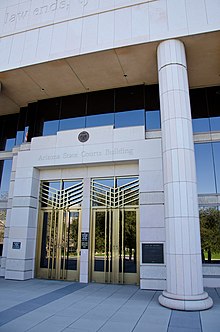Arizona Supreme Court
| Arizona Supreme Court | |
|---|---|
 Seal of the Arizona Supreme Court | |
 | |
| Established | 1912 |
| Jurisdiction | Arizona |
| Location | Phoenix, Arizona |
| Composition method | Missouri plan with retention elections |
| Authorised by | Arizona Constitution |
| Appeals to | Supreme Court of the United States |
| Judge term length | 6 years |
| Number of positions | 7 |
| Website | Official site |
| Chief Justice | |
| Currently | Ann Timmer |
| Since | July 1, 2024 |
| Lead position ends | June 30, 2029[1] |
The Arizona Supreme Court is the state supreme court of the U.S. state of Arizona. Sitting in the Supreme Court building in downtown Phoenix, the court consists of a chief justice, a vice chief justice, and five associate justices. Each justice is appointed by the governor of Arizona from a list recommended by a bipartisan commission. Justices stand for retention in an election two years after their appointment and then every six years.[2] They must retire at age 70.
Court history
[edit]The court started in 1912 with three justices. Alfred Franklin, Donald L. Cunningham, and Henry D. Ross took office on February 14, 1912. In 1949, the Court expanded from three to five justices.[3] In 2016 it was further expanded from five to seven justices.[4] This expansion was criticized at the time by some as court packing.[5]
The jurisdiction of the court is prescribed by Article VI, Section 5 of the Arizona Constitution.[6] Most of the appeals heard by the court go through the Arizona Court of Appeals, except for death penalty cases, over which the Arizona Supreme Court has sole appellate jurisdiction. The court also has original jurisdiction in a few other circumstances as outlined in the Arizona Constitution. A quorum is three, but the whole court must sit in order to declare a law unconstitutional.[7]
Selection of justices
[edit]
The Chief Justice is chosen for a five-year term by the court, and is eligible for re-election. They supervise the administration of all the inferior courts. They are Chairman of the Commission on Appellate Court Appointments, which nominates candidates to fill vacancies in the appellate courts. If the Governor fails to appoint one of the nominated candidates within sixty days of their names being submitted to her or him, the Chief Justice makes the appointment.
The Vice Chief Justice, who acts as Chief Justice in the latter's "absence or incapacity," is chosen by the court for a term determined by the court.[8]
Justices are selected by a modified form of the Missouri Plan. A bipartisan commission considers applicants and sends a list of nominees to the governor. The governor is required by law to appoint from this list based on merit, without regard to party affiliation. Justices are then retained for an initial period, after which they are subject to a retention election. If the justice wins the election, their term is six years.
Between February to April 2024, the Arizona Senate (with all Republican state senators approving and all Democratic state senators objecting) passed a resolution to change the Arizona Supreme Court term length from six years to lifelong, which would apply retroactively and override the result of the November 2024 Arizona Supreme Court retention elections; the resolution was approved by[9] Arizona House of Representatives and is awaiting voter approval.[10]
Qualifications
[edit]- Admitted to the practice of law in Arizona and be a resident of Arizona for the 10 years before taking office;
- May not practice law while a member of the judiciary;
- May not hold any other political office or public employment;
- May not hold office in any political party;
- May not campaign, except for him/herself; and,
- Must retire at age 70.[11]
Justices
[edit]The current Arizona Supreme Court includes:
| Justice | Born | Joined | Chief Justice | Term ends[a] | Mandatory retirement | Appointed by | Law school |
|---|---|---|---|---|---|---|---|
| Ann Timmer, Chief Justice | September 12, 1960 | October 12, 2012 | 2024–present | 2028 | 2030 | Jan Brewer (R) | Arizona State |
| John Lopez IV, Vice Chief Justice | 1968 (age 56–57) | December 19, 2016 | – | 2026 | 2038 | Doug Ducey (R) | Arizona State |
| Clint Bolick | December 26, 1957 | January 6, 2016 | – | 2030 | 2027 | Doug Ducey (R) | UC Davis |
| James Beene | 1965 (age 59–60) | April 26, 2019 | – | 2028 | 2035 | Doug Ducey (R) | University of Arizona |
| Bill Montgomery | March 2, 1967 | September 6, 2019 | – | 2028 | 2037 | Doug Ducey (R) | Arizona State |
| Kathryn Hackett King | 1980 (age 44–45) | July 8, 2021 | – | 2030 | 2050 | Doug Ducey (R) | University of Arizona |
| Vacant | – |
- ^ Term ends Dec. 31 of the year listed.
Chief Justice Ann Timmer | Vice Chief Justice John Lopez IV | Justice Clint Bolick | Justice James Beene | Justice Bill Montgomery | Justice Kathryn Hackett King |
Vacancy and pending nomination
[edit]| Seat | Seat last held by | Vacancy reason | Date of vacancy | Nominee | Date of nomination |
|---|---|---|---|---|---|
| — | Robert M. Brutinel | Retirement | October 31, 2024[12] | – | – |
Chief Justices
[edit]- Alfred Franklin (1912–1914, 1917)
- Henry D. Ross (1915–1916, 1921–1922, 1927–1928, 1933–1934, 1939–1940, 1945)
- Donald L. Cunningham (1918–1920)
- Archibald G. McAlister (1923–1926, 1931–1932, 1937–1938, 1943–1944)
- Alfred C. Lockwood (1929–1930, 1935–1936, 1941–1942)
- Rawghlie Clement Stanford (1945–1948)
- Arthur T. LaPrade (1949–1950, 1955–1956)
- Levi Stewart Udall (1951–1952)
- Rawghlie Clement Stanford (1953–1953)
- Marlin T. Phelps (1954–1954, 1959)
- Levi Stewart Udall (1957–1958)
- Fred C. Struckmeyer Jr. (1960–1961, 1966, 1971, 1980–1981)
- Charles C. Bernstein (1962–1963, 1967–1967)
- Jesse Addison Udall (1964–1964, 1969)
- Lorna E. Lockwood (1965–1965, 1970) (First female chief justice in the United States)
- Ernest McFarland (1968–1968)
- Jack D. H. Hays (1972–1974)
- James Duke Cameron (1975–1979)
- William A. Holohan (1982–1987)
- Frank Gordon Jr. (1987–1992)
- Stanley G. Feldman (1992–1997)
- Thomas A. Zlaket (1997–2002)
- Charles E. Jones (2002–2005)
- Ruth McGregor (2005–2009)
- Rebecca White Berch (2009–2014)
- Scott Bales (2014–2019)
- Robert M. Brutinel (2019–2024)
- Ann Timmer (2024-present)
Notable cases
[edit]- Harrison v. Laveen, 67 Ariz. 337, 196 P.2d 456 (1948), a case in which the Court held that the state constitution's use of the phrase "persons under guardianship" applied only to judicial guardianship and had "no application to the plaintiffs or to the Federal status of Indians in Arizona as a class."[13]
- Spur Industries, Inc. v. Del E. Webb Development Co., 108 Ariz. 178, 494 P.2d 700 (1972), a case addressing the principles of nuisance law.
- Planned Parenthood Arizona v. Mayes, CV-23-0005-PR (2024), a case upholding Arizona's abortion ban enacted in 1864.[14]
See also
[edit]References
[edit]- ^ "Supreme Court of Arizona - Administrative Order No. 2024-17" (PDF).
- ^ Ariz. Const. Art. VI, § 37.
- ^ William O. Douglas, Arizona's New Judicial Article, 2 ARIZ. L. REV. 159 (1960).
- ^ "Bill Would Add 2 New Justices To Arizona Supreme Court". KJZZ. February 25, 2016.
- ^ Berman, Russell (2016-05-10). "Arizona Republicans Try to Bring Back Court-Packing". The Atlantic. Retrieved 2024-04-09.
- ^ Ariz. Const. Art. VI, § 5.
- ^ Ariz. Const. Art. VI, § 2.
- ^ Ariz. Const. Art. VI, § 3.
- ^ "Bill Status Inquiry". apps.azleg.gov. Retrieved 2024-09-27.
- ^ Priest, Regan (April 19, 2024). "GOP-backed ballot measure would keep Arizona Supreme Court intact, even justices voted out". Arizona Republic. Archived from the original on April 19, 2024. Retrieved April 20, 2024.
- ^ "AZ Supreme Court". www.azcourts.gov.
- ^ Barchenger, Stacy (September 24, 2024). "AZ Supreme Court Justice Robert Brutinel will retire in October". Arizona Republic. Archived from the original on September 24, 2024.
- ^ Ferguson-Bohnee, Patty. "The History of Indian Voting Rights in Arizona: Overcoming Decades of Voter Suppression" (PDF). Arizona State Law Journal: 1099–1112.
- ^ "Planned Parenthood Arizona v. Mayes". League of Women Voters. Retrieved 10 April 2024.






